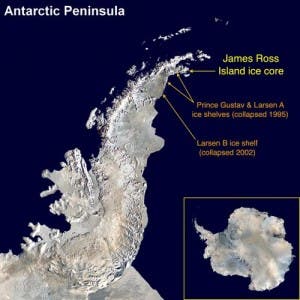
A new study that examined ice core samples found that parts of Antarctica‘s ice are melting at at the highest pace this millennium. The findings put modern global warming into a historical context emphasizing the link between human induced climate change and rapid ice melting in the Arctic, considering it has increased tenfold since the dawn of the past millennium and much of this increase has occurred since the mid-XXth century.
Previous studies have also highlighted the dramatic extent of Antarctic ice melt, however scientists and skeptics alike weren’t sure just how abnormal this is with respect to the continent’s history of melting and freezing cycles. This find out, Nerilie Abram, of the Australian National University in Canberra, along with colleagues drilled and examined a 364-metre-long ice core spanning 1000 years from the tip of the west Antarctic Peninsula. The ice core is etched by layers upon layers, each showing how this part of the continent behaved during the summer melt and winter freeze, based on the thickness of these layers.
The researchers found that the coldest period and lowest ice melt in the past millennium was 600 years ago, when just 0.5 per cent of snowfall melted and refroze each year. In contrast, by the turn of the XXth century that figure had doubled and in a mere 100 years it had increased by a factor of ten – startling figures which are difficult to be accounted to a natural occurring climate change. As the authors themselves note, ice melt in the Antarctic Peninsula is almost certainly caused by human-induced climate change.
“What that means is that the Antarctic Peninsula has warmed to a level where even small increases in temperature can now lead to a big increase in summer ice melt,” study co-author Nerilie Abram, a researcher at the Australian National University and the British Antarctic Survey, said in a statement.
What’s worrisome is that the findings show that even an increase in global temperatures of one degree Celsius can have dramatic consequences on ice melting. Rapid melt can destabilize glaciers and ice shelves (the tongues of glaciers that float on the ocean), suggesting that there could be some dramatic collapses and a resulting increase in sea levels if the melting continues. It’s estimated Antarctica holds 90% of the world’s ice.
“It’s an example of a system where there’s a potential for rapid changes once you get to a threshold,” says Abram
Findings were detailed in the journal Nature Geoscience.






